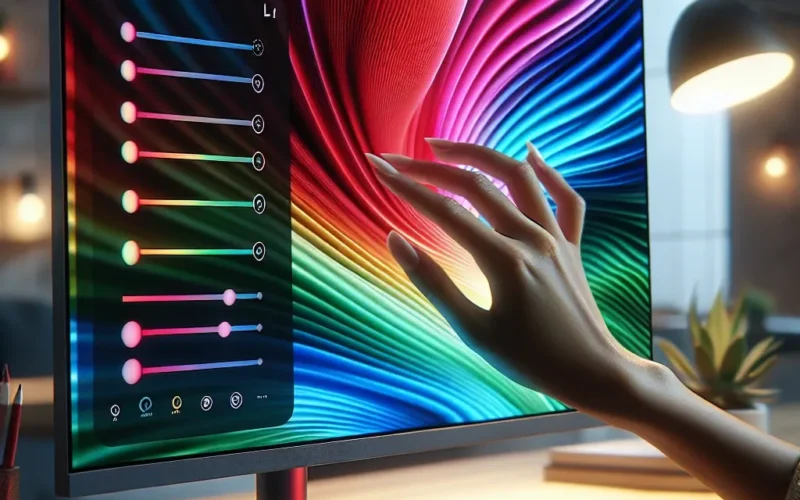An LED monitor offers impressive display capabilities, but to harness its full potential, understanding how to adjust the color settings is essential. Color settings can influence your overall experience, whether you’re gaming, doing graphic design, or simply browsing the web. This guide provides step-by-step instructions to adjust the color settings on your LED monitor for optimal display quality.
| Purpose | Recommended Settings |
|---|---|
| Gaming | High contrast, vibrant colors, low blue light |
| Graphic Design | Accurate color representation, high resolution |
| Everyday Use | Balanced brightness and contrast |
1. Understanding Your LED Monitor’s Color Settings
Before diving into adjustments, it is important to get familiar with various color settings on your LED monitor. Common settings include brightness, contrast, saturation, and color temperature.
1.1 Brightness
Brightness refers to the luminescence of the display. Too high or low brightness can cause eye strain.
1.2 Contrast
Contrast adjusts the difference between the darkest blacks and the brightest whites on the screen. High contrast generally provides more vibrant images but may affect color accuracy.
1.3 Saturation
Saturation controls the intensity of colors on the screen. Higher saturation makes colors more vivid, while lower saturation can make them appear muted.
1.4 Color Temperature
Color Temperature adjusts the warmth or coolness of the colors on the display. A lower color temperature results in a warmer (more yellow) color, while a higher color temperature makes the color cooler (more blue).
2. Steps to Adjust Color Settings on an LED Monitor
Follow these steps to adjust your color settings:
2.1 Using the Monitor’s On-Screen Display (OSD) Menu
- Locate the Menu button on your monitor.
- Navigate to the color settings using the directional buttons.
- Adjust the brightness, contrast, saturation, and color temperature according to your preference.
- Save the settings and exit the OSD menu.
2.2 Using Operating System Color Calibration Tools
Both Windows and macOS provide built-in tools for color calibration.
2.2.1 Windows
- Right-click on the desktop and select Display settings.
- Scroll down and click on Advanced display settings.
- Select Color calibration.
- Follow the on-screen instructions to adjust your settings.
2.2.2 macOS
- Open System Preferences.
- Choose Displays and then Color.
- Click on Calibrate and follow the on-screen instructions.
2.3 Using Third-Party Calibration Tools and Software
For more advanced calibration, consider using third-party tools and software such as:
- SpyderX by Datacolor
- X-Rite ColorMunki
- CalMAN
3. Special Considerations for Professional Users
If you use your LED monitor for professional tasks such as photography, video editing, or graphic design, accurate color representation is crucial. Investing in high-quality calibration tools and periodically recalibrating your monitor ensures that colors remain consistent and true.
3.1 Monitor Calibration Hardware
Devices like the SpyderX by Datacolor or the X-Rite i1Display Pro measure your screen’s color accuracy and create a custom color profile that compensates for any discrepancies.
3.2 Professional Calibration Services
Consider hiring a professional calibration service if precise color accuracy is critical for your work. They use high-end equipment and expert knowledge to achieve the best results.
4. Maintaining Your Monitor’s Color Accuracy
Maintaining color accuracy is an ongoing process. Here are some tips to keep your monitor’s color settings optimal:
- Regularly recalibrate your monitor using built-in tools or third-party software.
- Avoid exposing your monitor to direct sunlight, as it can affect color accuracy.
- Ensure your monitor is clean and free from dust or smudges.
5. Common Issues and Troubleshooting
Even with the best settings, you may encounter issues. Here are some common problems and how to solve them:
5.1 Color Banding
Color banding occurs when gradients don’t transition smoothly. Reducing contrast or recalibrating your monitor can help mitigate this.
5.2 Colors Look Washed Out
If colors appear washed out, increasing the saturation or contrast can improve the vibrancy of the display.
5.3 Monitor Not Saving Settings
If your monitor isn’t saving settings, ensure that you are exiting the OSD menu properly after making adjustments. Refer to your monitor’s user manual for specific instructions.
Adjusting the color settings on your LED monitor can significantly enhance your visual experience, whether you are gaming, working, or simply browsing. Take time to experiment with different settings and tools to find what works best for you.

